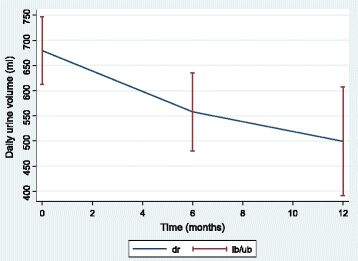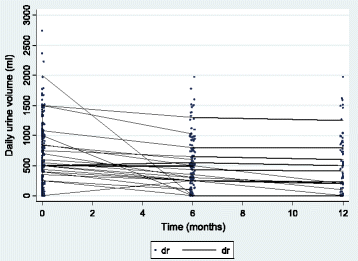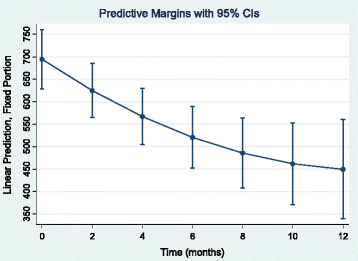Factors associated with residual urine volume preservation in patients undergoing hemodialysis for end-stage kidney disease in Kinshasa
- PMID: 29554877
- PMCID: PMC5859481
- DOI: 10.1186/s12882-018-0865-x
Factors associated with residual urine volume preservation in patients undergoing hemodialysis for end-stage kidney disease in Kinshasa
Abstract
Background: Decreased residual urine volume (RUV) is associated with higher mortality in hemodialysis (HD). However, few studies have examined RUV in patients on HD in Sub-Saharan Africa. The aim of this study was to identify predictors of RUV among incident hemodialysis patients in Kinshasa.
Methods: This historical cohort study enrolled 250 patients with ESRD undergoing hemodialysis between January 2007 and July 2013 in two hemodialysis centers in Kinshasa. RUV were collected over 24 h at the initiation of HD and 6 and 12 months later during the interdialytic period. We compared the baseline characteristics of the patients according to their initial RUV (≤ 500 ml/day vs > 500 ml/day) using Student's t, Mann-Whitney U and Chi2 tests. Linear mixed-effects models were used to search for predictors of decreased RUV by adding potentially predictive baseline covariates of the evolution of RUV to the effect of time: age, sex, diabetes mellitus, hypertension, diastolic blood pressure, diuretics, angiotensin conversion enzyme inhibitors (ACEI), angiotensin receptor blockers, hypovolemia, chronic tubulointerstitial nephropathy, left ventricular hypertrophy and initial hemodialysis characteristic. A value of p < 0.05 was considered the threshold of statistical significance.
Results: The majority of hemodialysis patients were male (68.8%, sex ratio 2.2), with a mean age of 52.5 ± 12.3 years. The population's RUV decreased with time, but with a slight deceleration. The mean RUV values were 680 ± 537 ml/day, 558 ± 442 ml/day and 499 ± 475 ml/day, respectively, at the initiation of HD and at 6 and 12 months later. The use of ACEI at the initiation of HD (beta coefficient 219.5, p < 0.001) and the presence of chronic tubulointerstitial nephropathy (beta coefficient 291.8, p = 0.007) were significantly associated with RUV preservation over time. In contrast, the presence of left ventricular hypertrophy at the initiation of HD was significantly associated with decreased RUV over time (beta coefficient - 133.9, p = 0.029).
Conclusions: Among incident hemodialysis patients, the use of ACEI, the presence of chronic tubulointerstitial nephropathy and reduced left ventricular hypertrophy are associated with greater RUV preservation in the first year of dialysis.
Conflict of interest statement
Ethics approval and consent to participate
The Ethics Committee of the Faculty of Medicine, University of Kinshasa approved the implementation of this study.
Consent for publication
Not applicable
Competing interests
The authors declare that they have no competing interests.
Publisher’s Note
Springer Nature remains neutral with regard to jurisdictional claims in published maps and institutional affiliations.
Figures



Similar articles
-
Impact of residual urine volume decline on the survival of chronic hemodialysis patients in Kinshasa.BMC Nephrol. 2016 Nov 21;17(1):182. doi: 10.1186/s12882-016-0401-9. BMC Nephrol. 2016. PMID: 27871253 Free PMC article.
-
Should the preservation of residual renal function cost volume overload and its consequence left ventricular hypertrophy in new hemodialysis patients?Ren Fail. 2004 Jul;26(4):405-9. doi: 10.1081/jdi-120039825. Ren Fail. 2004. PMID: 15462109
-
Correlation between hypervolemia, left ventricular hypertrophy and fibroblast growth factor 23 in hemodialysis patients.Ren Fail. 2015 Jul;37(6):951-6. doi: 10.3109/0886022X.2015.1052945. Epub 2015 Jun 1. Ren Fail. 2015. PMID: 26030798
-
Hemodialysis-associated hypertension: pathophysiology and therapy.Am J Kidney Dis. 2002 Feb;39(2):227-44. doi: 10.1053/ajkd.2002.30542. Am J Kidney Dis. 2002. PMID: 11840363 Review.
-
Intensive Hemodialysis, Blood Pressure, and Antihypertensive Medication Use.Am J Kidney Dis. 2016 Nov;68(5S1):S15-S23. doi: 10.1053/j.ajkd.2016.05.026. Am J Kidney Dis. 2016. PMID: 27772639 Review.
Cited by
-
Residual Renal Function - How Fast Does the Residual Urine Output Function Decline in the First Year of Haemodialysis? - A Scoping Review.Front Nephrol. 2022 Jan 26;1:808909. doi: 10.3389/fneph.2021.808909. eCollection 2021. Front Nephrol. 2022. PMID: 37674814 Free PMC article.
-
On the importance of the interplay of residual renal function with clinical outcomes in end-stage kidney disease.J Nephrol. 2022 Dec;35(9):2191-2204. doi: 10.1007/s40620-022-01388-9. Epub 2022 Jul 11. J Nephrol. 2022. PMID: 35819749 Review.
-
Associations between echocardiographic findings and prospective changes in residual renal function in patients new to peritoneal dialysis.Sci Rep. 2019 Dec 5;9(1):18434. doi: 10.1038/s41598-019-54851-2. Sci Rep. 2019. PMID: 31804571 Free PMC article. Clinical Trial.
-
Lower urinary tract symptoms among male patients on hemodialysis: Prospective and multi-central cross-sectional study.SAGE Open Med. 2024 Jul 30;12:20503121241263302. doi: 10.1177/20503121241263302. eCollection 2024. SAGE Open Med. 2024. PMID: 39092156 Free PMC article.
References
-
- Moist LM, Port FK, Orzol SM, Young EW, Ostbye T, Wolfe RA, Hulbert-Shearon T, Jones CA, Bloembergen WE. Predictors of loss of residual renal function among new dialysis patients. J Am Soc Nephrol. 2000;11(3):556–564. - PubMed
MeSH terms
Substances
LinkOut - more resources
Full Text Sources
Other Literature Sources
Medical

